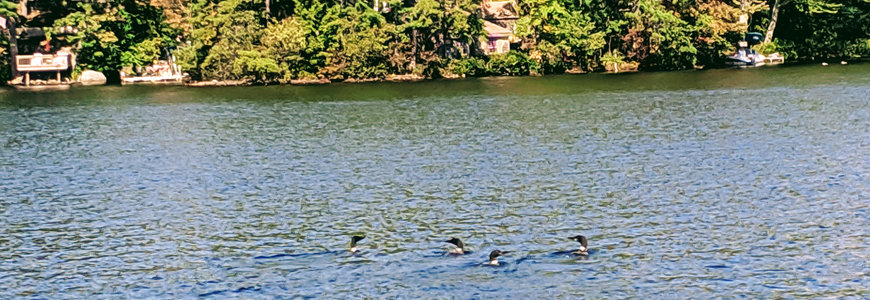This article is about the Loon Protection Challenges in Southern New Hampshire.
Right now, loons are making short migrations from freshwater lakes to the Atlantic coast for the winter, spreading out from roughly Maine to Rhode Island. Adult loons typically leave freshwater a few months after their chicks are born, but chicks tend to stick around the lake until just before ice forms. It’s a mystery how loon chicks find their way to the ocean in the fall, and how they know to do so. In winter, loons molt their black and white tuxedo feathers into a dullish-gray and white outfit. Even their eyes change color, from the piercing red we’re accustomed to seeing on a summer day to a dullish brown for the winter. While loons can efficiently catch fish in the ocean, the added amounts of salt would cause problems without the necessary adaptations. These adaptations include salt glands behind the forehead which remove salt from the water and fish they ingest, which can be excreted from glands in the bill.
Overall, it was a record year for breeding loons in New Hampshire. But their history is complicated – New Hampshire’s population hovered at a low of around just 50 pairs just a few decades ago. The Loon Preservation Committee (LPC) and its assemblage of volunteers continue to monitor and protect loon nests statewide.
This Summer, from a Loon’s Perspective
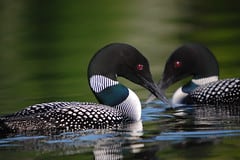 A total of six territorial loon pairs arrived on Barrington’s lakes this year. Five of those pairs built nests, but just three were successful at hatching a chick. Reports provided to the LPC revealed that one of the failed nests was due to human disturbance. Three chicks were hatched, and two of those survived into mid-August, which is when the LPC wraps up monitoring for the season.
A total of six territorial loon pairs arrived on Barrington’s lakes this year. Five of those pairs built nests, but just three were successful at hatching a chick. Reports provided to the LPC revealed that one of the failed nests was due to human disturbance. Three chicks were hatched, and two of those survived into mid-August, which is when the LPC wraps up monitoring for the season.
Caroline Hughes, the LPC’s outreach coordinator, addressed a full-house at the Barrington Library last week. “Since [the LPC] started work in the 1970s, the loon population has more than tripled,” said Hughes, “going from fewer than 100 pairs to a new record this year – 314 pairs within the state.” LPC data suggests that this number is still far from a full recovery and that New Hampshire has enough territory to support many more nesting birds. Loons are territorial during the breeding season, sometimes fighting to defend or take over territory on a lake. Males begin staking out their territory as soon as the ice clears from the lake, having an incredible ability to arrive the day-of or exactly the day after ice melts. Interestingly, loons are more attached to their lake of choice rather than a mate of choice.
Conservation Actions on the Water
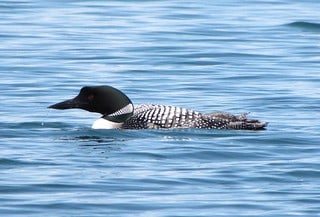 Barrington residents expressed frustrations with trying to protect loons on both Swain’s Lake and Mendum’s Pond, where reports of kayakers, blueberry pickers, and large boats caused repeated disturbance to nesting loons this summer. Part of the LPC’s protection efforts includes locating nest sites and erecting signs that alert lake-goers to the presence of nesting loons while asking people to give them plenty of space on the water. Unfortunately, in some areas, the placement of signs has the opposite effect – and curious paddlers, while not meaning any harm, cause the birds to leave the nest repeatedly due to their natural fear of humans. This can, and has, caused nest failure or complete nest abandonment. “Loons are a threatened species, and any harassment or take,” which could be any activity that directly causes the nest to fail, “is punishable by up to a $2,000 fine and a year in jail,” said Hughes. The LPC advises contacting an NH Fish and Game Conservation Officer to report any activity that is negatively impacting the birds.
Barrington residents expressed frustrations with trying to protect loons on both Swain’s Lake and Mendum’s Pond, where reports of kayakers, blueberry pickers, and large boats caused repeated disturbance to nesting loons this summer. Part of the LPC’s protection efforts includes locating nest sites and erecting signs that alert lake-goers to the presence of nesting loons while asking people to give them plenty of space on the water. Unfortunately, in some areas, the placement of signs has the opposite effect – and curious paddlers, while not meaning any harm, cause the birds to leave the nest repeatedly due to their natural fear of humans. This can, and has, caused nest failure or complete nest abandonment. “Loons are a threatened species, and any harassment or take,” which could be any activity that directly causes the nest to fail, “is punishable by up to a $2,000 fine and a year in jail,” said Hughes. The LPC advises contacting an NH Fish and Game Conservation Officer to report any activity that is negatively impacting the birds.
The development along shorelines of lakes and ponds has dramatically reduced suitable nesting spots. Loons require an undisturbed, leafy or shrubby nest location that is just at the water’s edge. “Loons have really high nest site fidelity, especially if they’ve been successful there in the past,” said Hughes. At the start of the spring breeding season, LPC floats about 100 vegetated rafts across the state to serve as makeshift nest locations. “Usually we try to only put rafts out on lakes that really need them because we think it’s better for loons to nest naturally, and we don’t want them to become dependent on human intervention,” stated Hughes. The LPC places a nesting raft on a lake that has experienced three consecutive years of no reproductive output, and where evidence exists that those nest failures are related to some situation that could be improved by having a raft in place. Some Barrington residents suggested that Mendum’s Pond would be a future candidate for the installment of a nesting raft.
Get the Lead Out – of Stonehouse Pond & Elsewhere
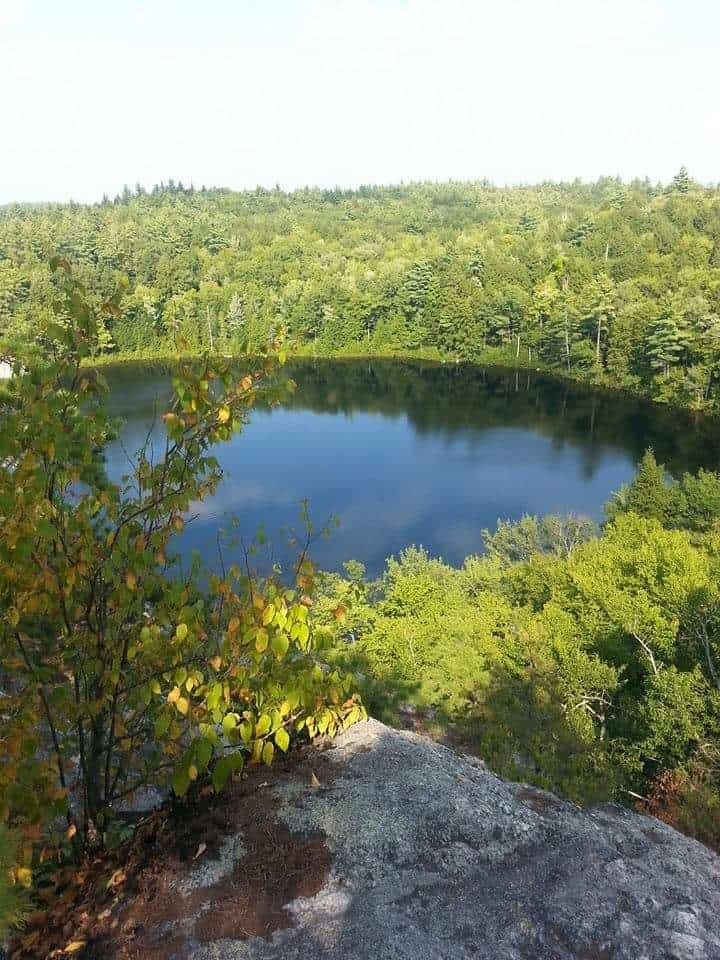 In August, LPC staff rescued a sick loon from Stonehouse Pond in Barrington. The loon was still alive at the time of rescue, but “a blood test showed that it had fatally high lead levels,” reported Hughes. The loon did not survive. Although nest failure impacts the overall population number, the biggest threat to loons continues to be a much more deadly hazard - lead fishing sinkers. Lacking teeth and the ability to chew up food, loons swallow tiny pebbles at the bottoms of lakes to help grind and digest their catch. All too often, lead tackle is unintentionally ingested along with those pebbles. With almost half of adult loon deaths attributed to lead poisoning, the state moved to ban the sale and freshwater use of any lead sinker or jig in 2016. However, deaths related to lead-poisoning still come up each year.
In August, LPC staff rescued a sick loon from Stonehouse Pond in Barrington. The loon was still alive at the time of rescue, but “a blood test showed that it had fatally high lead levels,” reported Hughes. The loon did not survive. Although nest failure impacts the overall population number, the biggest threat to loons continues to be a much more deadly hazard - lead fishing sinkers. Lacking teeth and the ability to chew up food, loons swallow tiny pebbles at the bottoms of lakes to help grind and digest their catch. All too often, lead tackle is unintentionally ingested along with those pebbles. With almost half of adult loon deaths attributed to lead poisoning, the state moved to ban the sale and freshwater use of any lead sinker or jig in 2016. However, deaths related to lead-poisoning still come up each year.
While the sale and use are illegal, “possession is not,” said Hughes, making “the enforcement of that law quite difficult.” It’s imperative that any angler, especially the most casual who may have an old tackle box, dispose of any lead equipment. A lead tackle buy-back program is still in effect across the state, where anyone can bring in one ounce or more of lead tackle and receive a $10 voucher to buy safe, replacement tackle from participating shops. Pawtuckaway Trading Post in Raymond is a nearby establishment participating in the buy-back program. So far, New Hampshire citizens have participated, “collecting almost 5,000 individual pieces of tackle weighing 30 pounds,” reported Hughes. A related hazard to all birds is leftover fishing line. All lake-goers are urged to take any line and tackle with them after a day of fishing and clean up any broken line you come across.
Looking Forward: A Big Threat & A Big Task
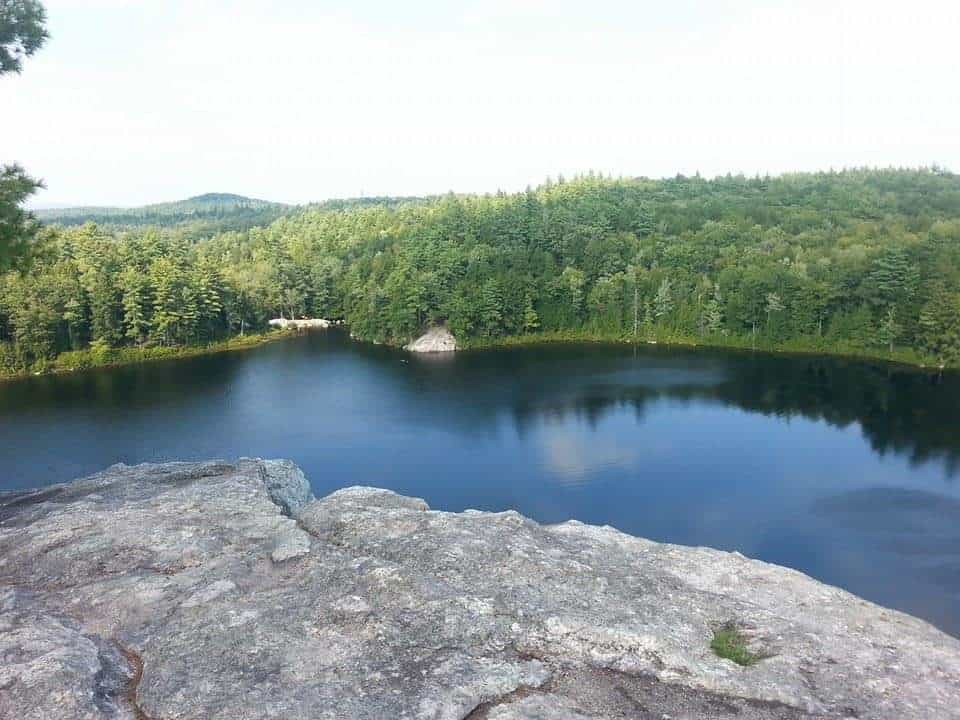 Long term, climate change is an imminent threat for loons – being a northern species that inhabit lakes as far south as Connecticut and New York up through Canada and Alaska. Last year on Spofford Lake, a juvenile loon got “iced in”, meaning it didn’t leave the lake before iced started to form. When the weather is warm and sunny far into the fall months, the natural cues that nudge the bird to leave for the ocean are absent. During this time, loons begin their annual molt – losing all their feathers at once and rendering them flightless. The molt can be stressful for the birds, since its energy-demanding. This flightless-ness wouldn’t be an issue for birds that have already settled into the ocean for winter – but for those still on the lake, the birds are stuck there as ice begins to form. In these cases, LPC attempts rescues, which seem to be increasing in frequency – possibly related to climate change. “The Audubon report that was done in 2015 on bird responses to climate change indicates that within the next one-hundred years, the loon breeding range will totally be pushed northward out of the United States,” said Hughes. The LPC is looking at what the mechanism of that movement might be, and if there is a way to delay or prevent it.
Long term, climate change is an imminent threat for loons – being a northern species that inhabit lakes as far south as Connecticut and New York up through Canada and Alaska. Last year on Spofford Lake, a juvenile loon got “iced in”, meaning it didn’t leave the lake before iced started to form. When the weather is warm and sunny far into the fall months, the natural cues that nudge the bird to leave for the ocean are absent. During this time, loons begin their annual molt – losing all their feathers at once and rendering them flightless. The molt can be stressful for the birds, since its energy-demanding. This flightless-ness wouldn’t be an issue for birds that have already settled into the ocean for winter – but for those still on the lake, the birds are stuck there as ice begins to form. In these cases, LPC attempts rescues, which seem to be increasing in frequency – possibly related to climate change. “The Audubon report that was done in 2015 on bird responses to climate change indicates that within the next one-hundred years, the loon breeding range will totally be pushed northward out of the United States,” said Hughes. The LPC is looking at what the mechanism of that movement might be, and if there is a way to delay or prevent it.
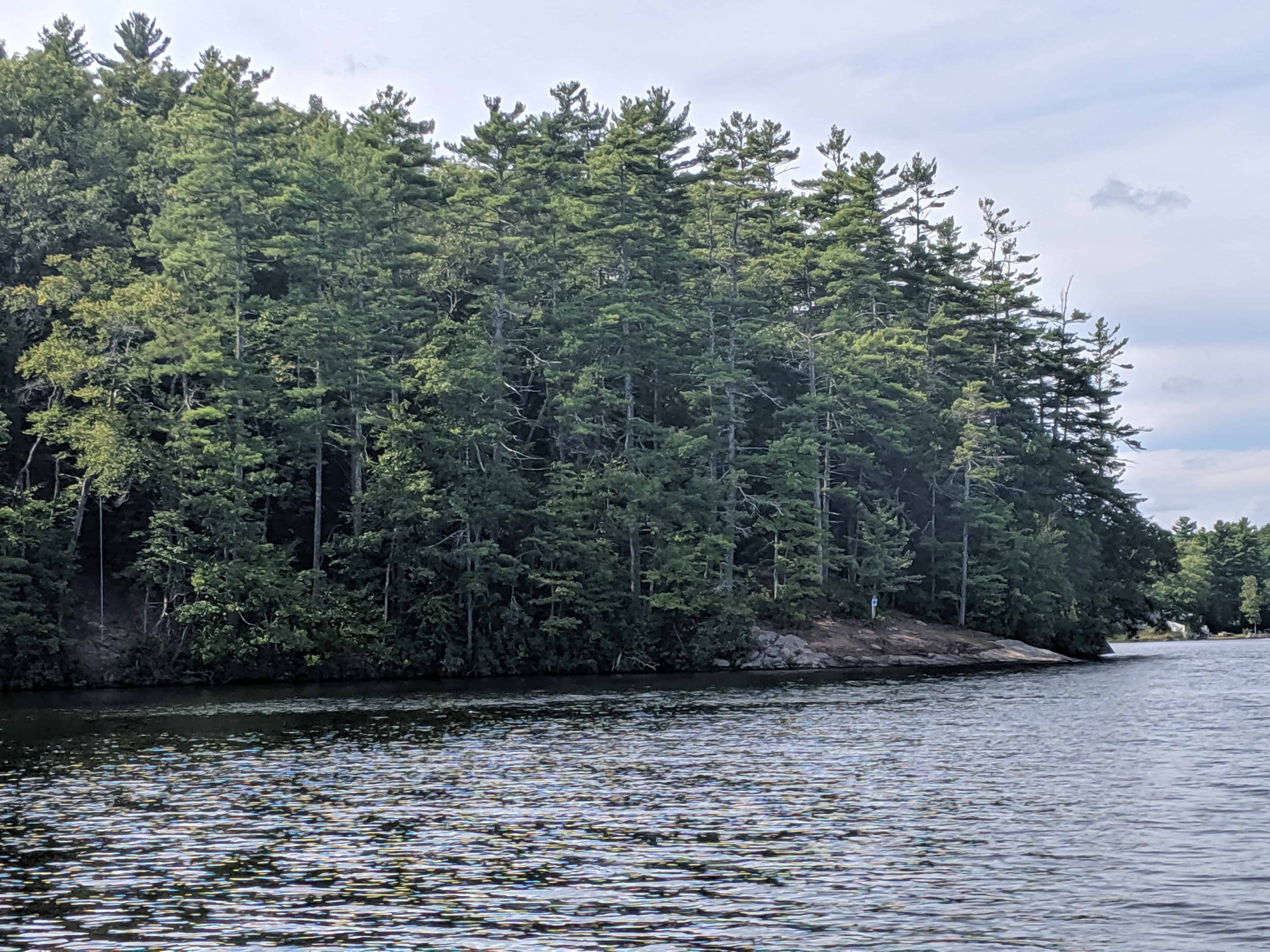 The LPC continues to research loon characteristics, like their maximum lifespan – which remains a mystery. Banding loons with unique color-patterned bands help collect information about age, where loons spend the winter, and how they move around to different water bodies during the summer. Some banded birds have reached thirty years old in New Hampshire, beating out the life expectancy of both Canada geese and common mallards. The LPC has an enormous job to do – leading statewide protection and research efforts. “We couldn’t do it without our volunteers,” said Hughes, “and there are many different tasks that our volunteers may take on,” ranging from monitoring or helping to put out floating signs, to providing storage space during the winter off-season. As a grass-roots nonprofit organization that is self-funded, it’s truly remarkable what the LPC network has been able to accomplish in New Hampshire.
The LPC continues to research loon characteristics, like their maximum lifespan – which remains a mystery. Banding loons with unique color-patterned bands help collect information about age, where loons spend the winter, and how they move around to different water bodies during the summer. Some banded birds have reached thirty years old in New Hampshire, beating out the life expectancy of both Canada geese and common mallards. The LPC has an enormous job to do – leading statewide protection and research efforts. “We couldn’t do it without our volunteers,” said Hughes, “and there are many different tasks that our volunteers may take on,” ranging from monitoring or helping to put out floating signs, to providing storage space during the winter off-season. As a grass-roots nonprofit organization that is self-funded, it’s truly remarkable what the LPC network has been able to accomplish in New Hampshire.
Loren Valliere-Tucker is a wildlife biologist and outdoor writer in southern New Hampshire. To collaborate on a story idea or writing project, she can be reached at This email address is being protected from spambots. You need JavaScript enabled to view it.. Photos of Stonehouse Pond submitted by Amy Valliere.



